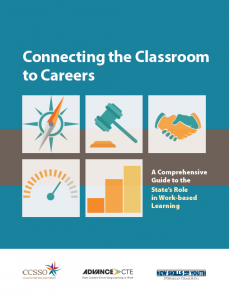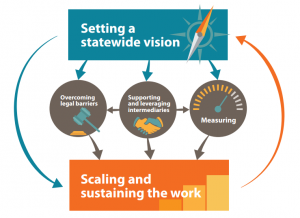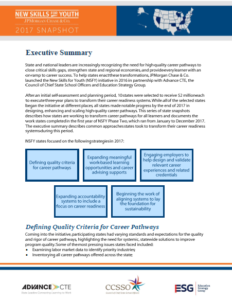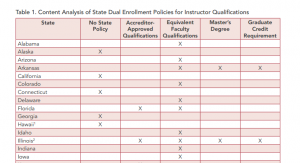 In a recent nationwide education poll, 90 percent of surveyed Americans said it is extremely or very important for schools to help students develop good work habits. In turn, state education agencies have begun to focus on both college and career readiness to help prepare students for their futures. One popular strategy is work-based learning, which allows students to reinforce and deepen their classroom learning, explore future career fields and demonstrate their skills in an authentic setting.
In a recent nationwide education poll, 90 percent of surveyed Americans said it is extremely or very important for schools to help students develop good work habits. In turn, state education agencies have begun to focus on both college and career readiness to help prepare students for their futures. One popular strategy is work-based learning, which allows students to reinforce and deepen their classroom learning, explore future career fields and demonstrate their skills in an authentic setting.
Today, Advance CTE released a comprehensive guide — building on the “Connecting the Classroom to Careers” policy series — to help policymakers develop and implement a statewide vision for work-based learning. The guide provides key considerations and guiding questions to walk state policymakers through the steps of building and scaling a high-quality work-based learning system, drawing on examples from states such as Tennessee and West Virginia to highlight innovative solutions to common challenges. The paper not only builds upon earlier briefs in the “Connecting the Classroom to Careers” series, but also ties them together into one comprehensive and easy-to-use guide.
To get started, states must develop a statewide vision for work-based learning and get buy-in from all relevant stakeholders. Tennessee, for example, embarked on a campaign to overhaul its work-based learning programs and establish a framework that would be more inclusive and relevant for students in the state. This resulted in a new, shared vision that prioritizes career exploration, career advisement and hands-on learning for all students — not just those enrolled in Career Technical Education (CTE) classes.
Yet setting a vision is only the first step. To ensure the vision is implemented successfully, states must create a policy environment that allows work-based learning programs to thrive. One of the biggest challenges that states face in expanding work-based learning opportunities is overcoming legal barriers, such as child labor laws and safety requirements, that make businesses reluctant to hire high school students. New Jersey demonstrates how state agencies can work together to develop a regulatory framework that supports, rather than inhibits, work-based learning opportunities. One product of inter-agency collaboration in the state is the New Jersey Safe Schools project, a comprehensive health and safety training for CTE teachers.
The guide further explores how states can expand work-based learning by partnering with intermediaries to facilitate partnerships between educators and employers for the ultimate benefit of a student’s career exploration and skill development. Intermediaries can be either independent organizations or, in the case of Georgia’s Youth Apprenticeship Program (YAP) Coordinators, individuals who are based within the school or district. Georgia’s YAP Coordinators are funded by a competitive state grant and help support the full range of work-based learning activities for local students.
 Once a statewide vision is in place and early implementation has begun, state policymakers should consider how to measure and scale work-based learning. There are two common approaches states take to building a comprehensive measurement and data-collection system: a systems-level approach that examines and evaluates the quality of the program, and a student-level approach that measures student learning and skill attainment. Through its School to Career Connecting Activities Initiative, Massachusetts has built a system to collect pre- and post-evaluations of student skills to determine both the professional and technical skills that students gain over the course of their work-based learning experience. This allows the state to assess difficult-to-measure student outcomes such as accepting direction and constructive criticism or motivation and taking initiative.
Once a statewide vision is in place and early implementation has begun, state policymakers should consider how to measure and scale work-based learning. There are two common approaches states take to building a comprehensive measurement and data-collection system: a systems-level approach that examines and evaluates the quality of the program, and a student-level approach that measures student learning and skill attainment. Through its School to Career Connecting Activities Initiative, Massachusetts has built a system to collect pre- and post-evaluations of student skills to determine both the professional and technical skills that students gain over the course of their work-based learning experience. This allows the state to assess difficult-to-measure student outcomes such as accepting direction and constructive criticism or motivation and taking initiative.
Collecting and evaluating program data enables states to not only identify promising practices but also to scale them statewide so that all students can access high-quality work-based learning experiences. One example profiled in the guide is West Virginia’s Simulated Workplace program, which began in 2013 as a pilot program in 20 schools across the state. The Department of Education gradually scaled the program, spending time evaluating and refining processes and policies along the way, to reach 60 schools — and more than 500 classrooms — by 2015.
There is no single way to build and scale work-based learning programs, but Advance CTE’s latest publication, “Connecting the Classroom to Careers: A Comprehensive Guide to the State’s Role in Work-based Learning,†can help states get started. The guide identifies essential strategies in work-based learning programs across the states and provides key takeaways and guiding questions to help states tackle common barriers. While work-based learning is a proven strategy to help students build technical and professional skills, policymakers should draw on examples from other states to thoughtfully build and scale a high-quality work-based learning system.
Austin Estes, Policy Associate and Ashleigh McFadden, State Policy Manager


 Throughout history, and continuing today, learners of color, low-income learners, female learners and learners with disabilities have been historically tracked into terminal vocational programs leading to jobs with uncertain promise of economic growth and prosperity.
Throughout history, and continuing today, learners of color, low-income learners, female learners and learners with disabilities have been historically tracked into terminal vocational programs leading to jobs with uncertain promise of economic growth and prosperity. What defines a high-quality career pathway? Is it alignment to labor market needs and career opportunities? The quality and qualifications of teachers and faculty? Access to meaningful, aligned work-based learning experiences? Perhaps all of the above?
What defines a high-quality career pathway? Is it alignment to labor market needs and career opportunities? The quality and qualifications of teachers and faculty? Access to meaningful, aligned work-based learning experiences? Perhaps all of the above? 
 Once a statewide vision is in place and early implementation has begun, state policymakers should consider how to measure and scale work-based learning. There are two common approaches states take to building a comprehensive measurement and data-collection system: a systems-level approach that examines and evaluates the quality of the program, and a student-level approach that measures student learning and skill attainment. Through its
Once a statewide vision is in place and early implementation has begun, state policymakers should consider how to measure and scale work-based learning. There are two common approaches states take to building a comprehensive measurement and data-collection system: a systems-level approach that examines and evaluates the quality of the program, and a student-level approach that measures student learning and skill attainment. Through its  Work-based learning provides a continuum of activities — from career exploration and job shadowing to internships and apprenticeships — that help students develop technical and professional skills in an authentic work environment. While many work-based learning programs are designed and operated at the local level, several states have begun building a data collection and evaluation strategy to ensure program quality, identify and scale successful programs, and share promising practices. To support state efforts in this work, Advance CTE today released a brief that explores strategies for measuring work-based learning.
Work-based learning provides a continuum of activities — from career exploration and job shadowing to internships and apprenticeships — that help students develop technical and professional skills in an authentic work environment. While many work-based learning programs are designed and operated at the local level, several states have begun building a data collection and evaluation strategy to ensure program quality, identify and scale successful programs, and share promising practices. To support state efforts in this work, Advance CTE today released a brief that explores strategies for measuring work-based learning. Many states allow students to earn credits in high school that can be applied towards a postsecondary degree or credential — a strategy known as dual, or concurrent, enrollment. While dual enrollment makes it easier and more affordable to obtain a postsecondary credential, states must pass policies to ensure students are receiving this advanced instruction from qualified teachers.
Many states allow students to earn credits in high school that can be applied towards a postsecondary degree or credential — a strategy known as dual, or concurrent, enrollment. While dual enrollment makes it easier and more affordable to obtain a postsecondary credential, states must pass policies to ensure students are receiving this advanced instruction from qualified teachers.